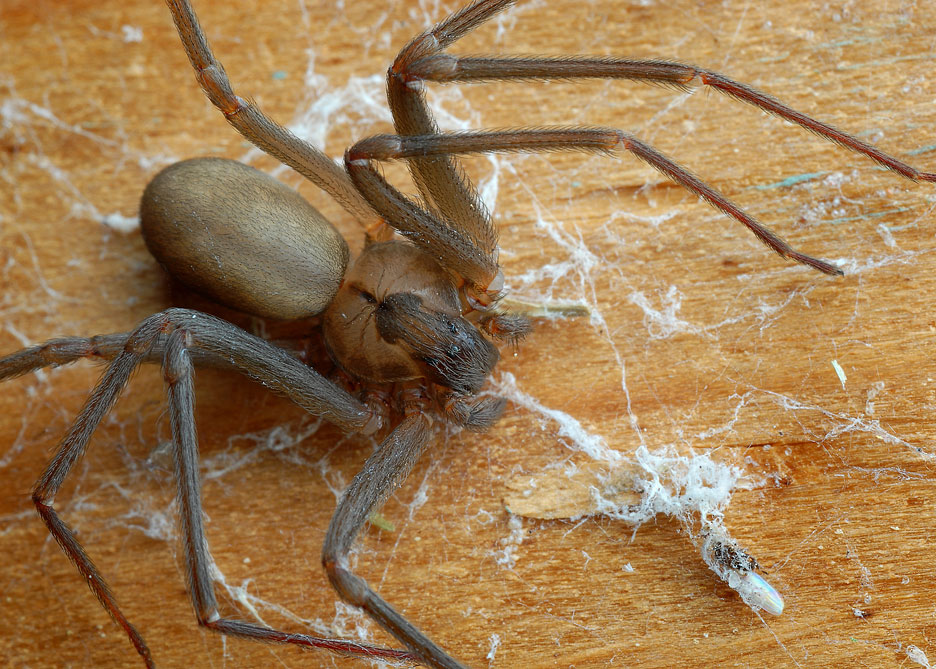Spiders
There’s an old naturalist’s saying that you’re never more than 5 feet from a spider. It’s probably true, as spiders can be found nearly everywhere, indoors and out. Despite their creepy reputation, spiders are largely beneficial and help keep pests like flies and plant-feeding insects under control. With few exceptions, spiders rarely bite and are not generally dangerous to people.
Spiders are arachnids and are more closely related to mites and scorpions than to insects. Like insects and other arthropods, arachnids have a hard outer exoskeleton and jointed legs. Arachnids are distinguished by having eight legs attached to the cephalothorax, which is the front body region and bears the head and thorax fused together.
Male spiders have modified palps (mouthparts) which serve as a sex organ.
The rear portion of a spider’s body, called the abdomen, has silk glands and web producing organs called spinnerets.
The spinnerets and a distinct abdomen distinguish spiders from the other arachnids. Female spiders are usually larger than the males.
Most spiders have eight simple eyes, though some species have six, four, two or no eyes at all. The pattern and number of eyes is useful in identifying spiders.
Almost all spiders bite and use venom to paralyze their prey. After injecting the venom, the prey is often wrapped with silk to subdue it. Many spiders live solely on a liquid diet because the powerful digestive enzymes injected by the fangs dissolve their prey’s body tissues. Spider venoms are being studied for possible uses in medicine and pest control.
Only two types of spiders in Texas are considered medically significant: the brown recluse, Loxoceles spp., and widow spiders, Latrodectus spp. Only a few other spiders, such as house spiders (Steatoda spp.) and sac spiders (Cheiracanthium spp.), can produce a noticeable bite.
Common Spiders
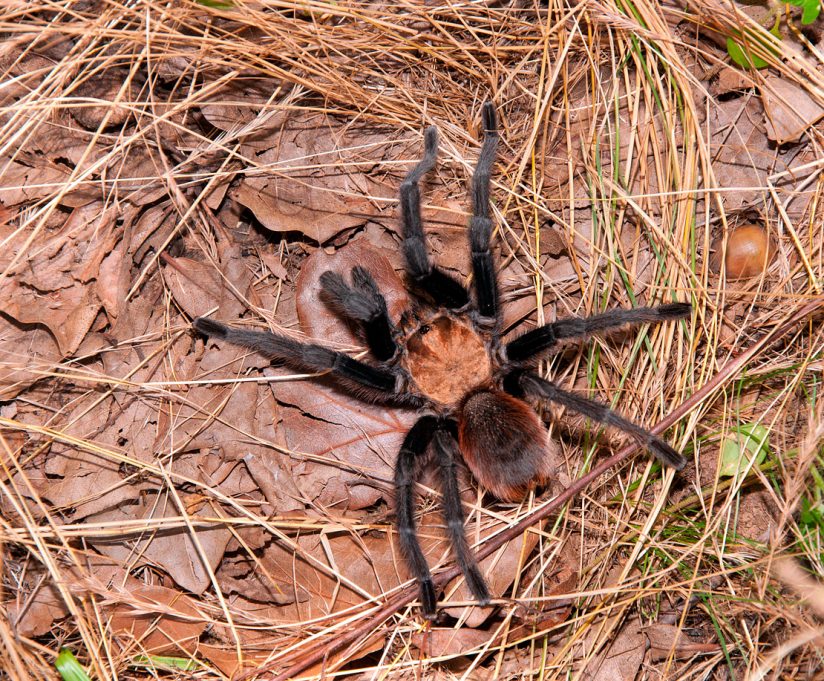
Tarantulas are among the largest spiders in Texas. Despite their size and fearsome reputation, tarantulas are shy and are seldom seen. The common Texas brown tarantula (genus Aphonopelma) can have leg spans of more than3 inches when fully grown.
During the day tarantulas live in burrows or in natural cavities under rocks or logs. The burrows are sometimes lined with silk webbing and are covered with a thin silk curtain. In the winter or the hottest months of summer, these burrows are plugged with soil. Tarantulas rarely go far from their burrow entrance; they wait for prey to come to them. Tarantulas can live 5 to 30 years.
During mating season, male tarantulas leave the burrow in search for females and can be seen in yards or even by the hundreds along Texas highways. Females live in their burrows after maturity and do not participate in these seasonal migrations.
Tarantula bites are not dangerous. When threatened, tarantulas rise up on their hind legs and wave their front legs to warn off predators. They also release abdominal hairs that can irritate skin, eyes or nasal passages of trespassers.
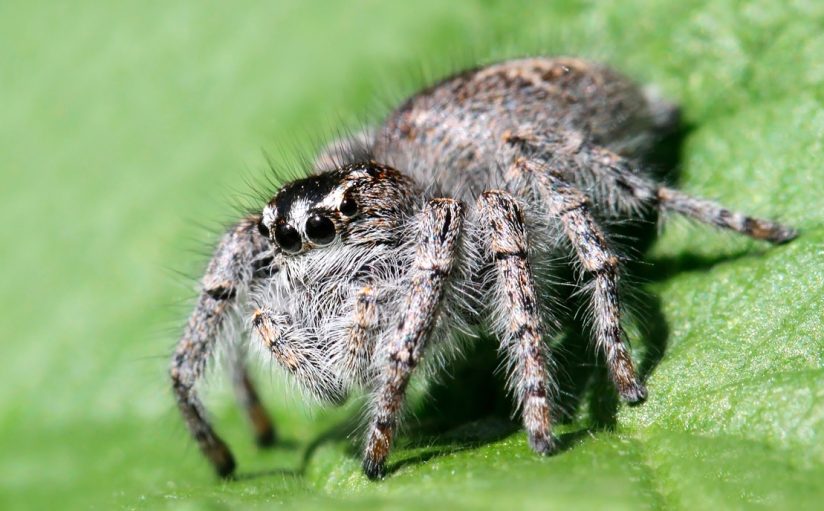
Jumping spiders, in the family Salticidae, are easy to distinguish from other spiders. Jumping spiders tend to be stocky and brightly colored. Some have conspicuous black and white bands on their bodies or legs. Common color patterns include browns, grays, black, brilliant red, yellow, and metallic or iridescent greens, blues, and coppers. Males are especially ornate and use their colors and mating dances to attract females.
Jumping spiders have excellent vision for hunting prey. They have eight eyes, including one large pair in the front. They are territorial and hunt during the day.
As their name implies, they are excellent jumpers. This behavior can startle observers, but like most spiders, jumping spiders are unlikely to bite unless cornered or handled. Jumping spiders put out a dragline of silk when they jump and can sometimes be seen dangling from this thread after a leap that fails.
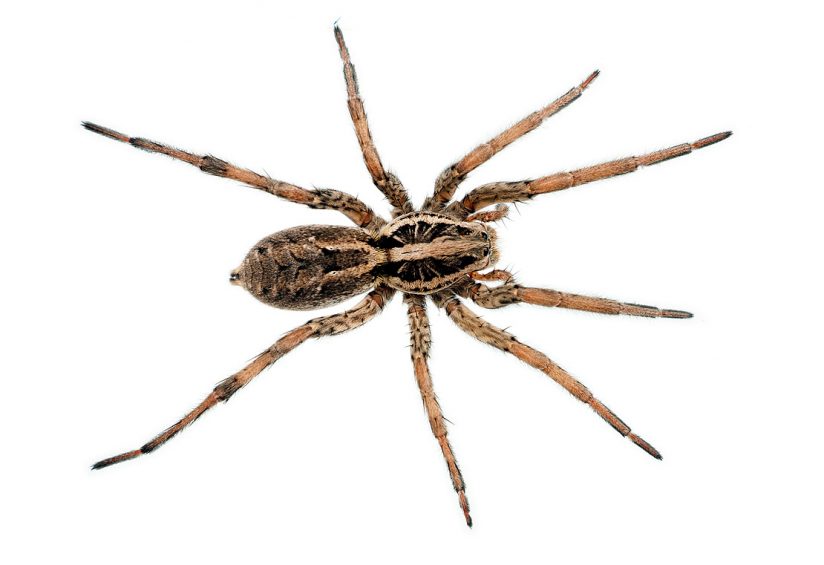
Wolf spiders, in the family Lycosidae, are among the most common spiders in fields and backyards. They are hairy and their drab color is mottled with brown, gray, black, yellow, or creamy white markings. They have eight eyes, with a front row of four tiny eyes in a straight line and a larger central pair in the hind row. Wolf spiders often have two dark, longitudinal stripes on the cephalothorax. They range 1/2 to 3 inches long.
Wolf spiders are most active after dark and have good night vision. During the summer, you can shine a flashlight into roadside grasses and see dozens of tiny pinpoints of light reflected on the wolf spiders’ enlarged pair of eyes.
Hundreds to thousands of wolf spiders may live in the average backyard lawn, where they feed on insects and small organisms. Although they may be a nuisance, they can control other pests. Because they are so plentiful, wolf spiders commonly enter homes under gaps in doorways. Although some wolf spiders can be aggressive if handled improperly, they are generally not dangerous to people or pets and can usually be picked up with bare hands or slid onto a piece of paper and relocated outdoors.
Female wolf spiders sometimes carry a round, silken egg case. They carry this case until the eggs hatch. The young climb onto their mother’s back and she carries the spiderlings with her until they are ready to hunt on their own.
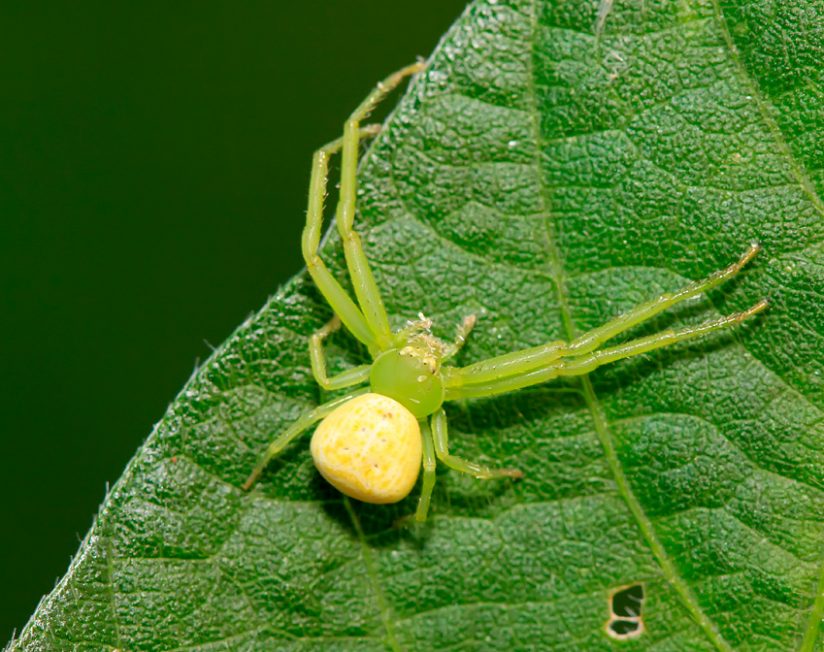
Crab spiders, in the family Thomisidae, are common on leaves and flowers (Fig. 8), and some species are found on the ground. These spiders are easily recognized by the crablike way they hold their two front pairs of legs and the way they scuttle sideways and backwards. These spiders do not spin a web, instead they ambush their insect prey. Some crab spider species can change color to match the flower on which they are perched.
Orbweaver Spiders
Orbweavers in the family Araneidae come in many shapes, colors, and sizes. Most orbweavers make a vertically hanging orb web with concentric rings of silk—a “typical” spider web.
Orb webs are marvels of architecture. The spider first establishes a bridge between two supports by drifting a thread of sticky silk on the wind until it catches the opposite support. After strengthening the bridge, the spider uses its own weight and the elastic properties of the silk to establish an initial silk triangle. Over many trips up and down the supports and the central triangle, the spider spins additional radii to build the web scaffold on which the orb will be spun. Then the spider spins the orb-weaver’s trademark series of concentric, sticky rings.
The spider uses up to seven different types of silk to build the web; the rings eventually trap flying prey.
Many spiders tear down and rebuild their webs daily. Spiders that are active during the day do this work each morning. Some spiders eat the webs and recycle up to 90 percent of the material every day.
Some of the larger orbweavers, known as Argiope spiders, weave a zipperlike seam of heavy silk into the web called a stabilimenta. The precise function of the stabilimenta is not known. One idea is that it serves as a warning to birds to avoid the web, reducing the need to rebuild as often. Stabilimenta also reflect UV light, which may make the web more attractive to flying insects.
Unlike jumping and wolf spiders, orbweavers do not see well. Instead, they use the web to get information from the environment and to locate insects that are caught in the web. Prey is usually quickly subdued by wrapping it in silk so the web is not destroyed. Though orbweavers are harmless to people, their large webs can be a nuisance.
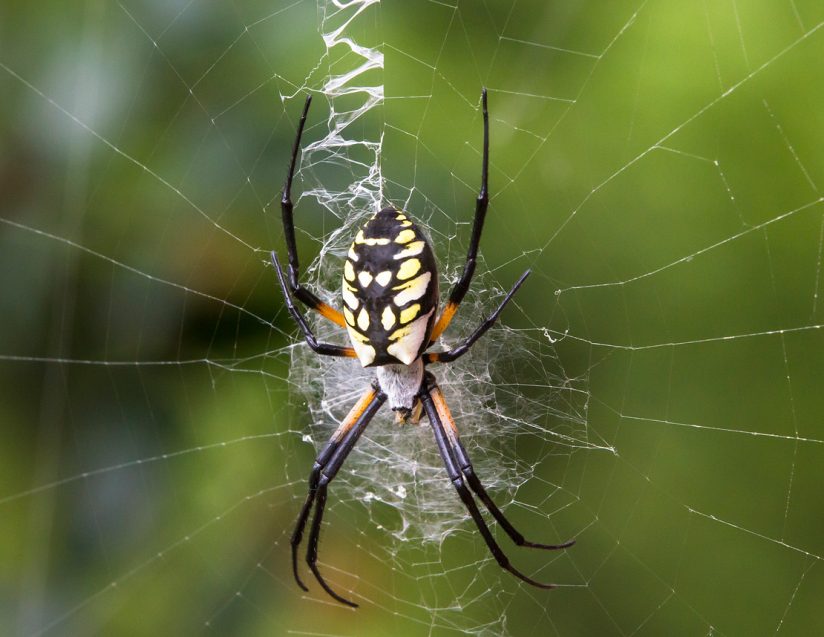
The black and yellow garden spider, Argiope aurantia, is common in Texas, and is the best known in the group. The female’s body is more than 1 inch long and its legs are even longer. Male Argiope are often less than one fourth the size of females and can be found in the same web with the female. Grasshopper-sized insects are often caught and eaten by these large spiders.
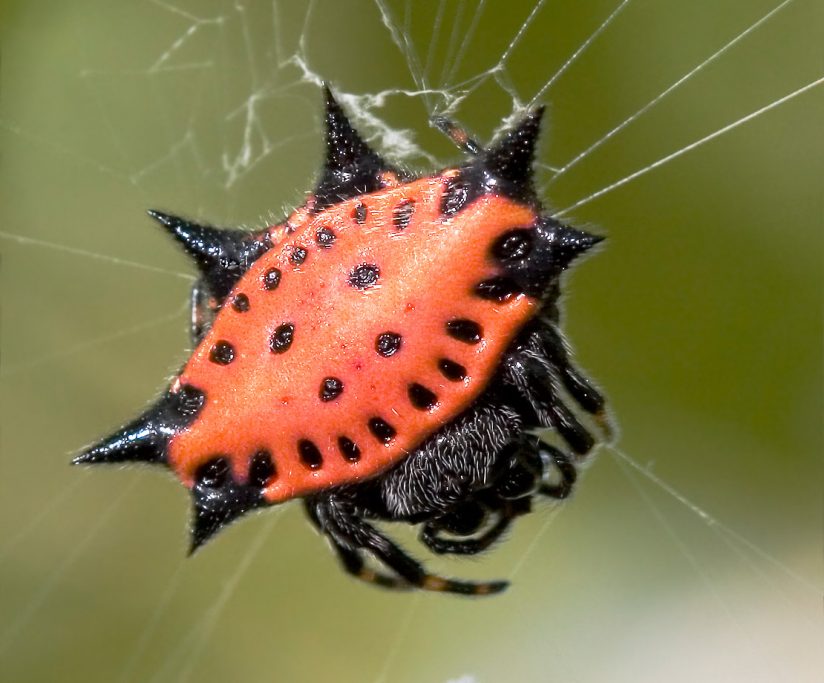
Spinybacked orbweavers from the genera Micrathena and Gasteracantha are distinctive spiders that are common in wooded areas. These spiders have a flattened, spiny shape that makes them resemble crabs. Their abdomen colors include white, yellow, orange, or red.
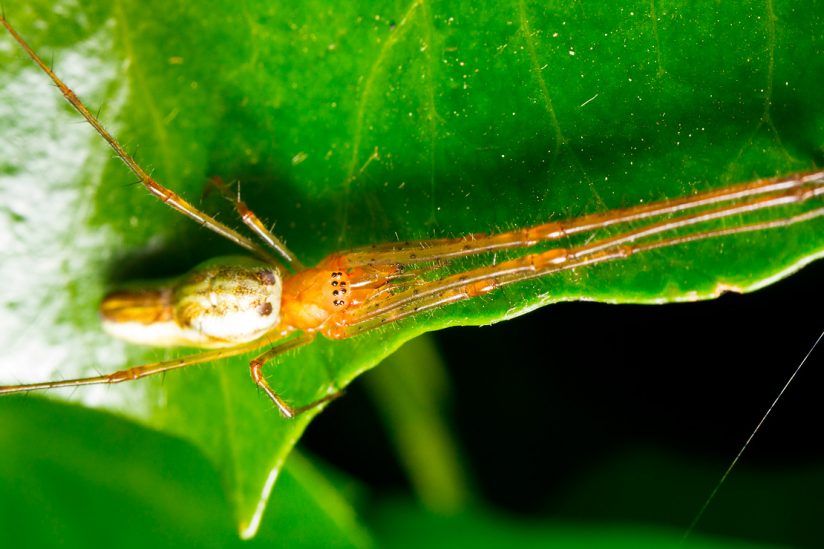
The long-jawed spider, in the family Tetragnathidae, is another common orbweaving spider. The name comes from their large chelicerae, or fangs. Their long jaws allow them to bite and secure their prey, though their venom is not considered dangerous to people.
In recent years, long-jawed orbweavers in the genus Tetragnatha have built large communal webs. These “super webs” are unusual and have most commonly been found near water, especially where there food sources like midges or other flying insects are abundant.
Potentially Dangerous Spiders
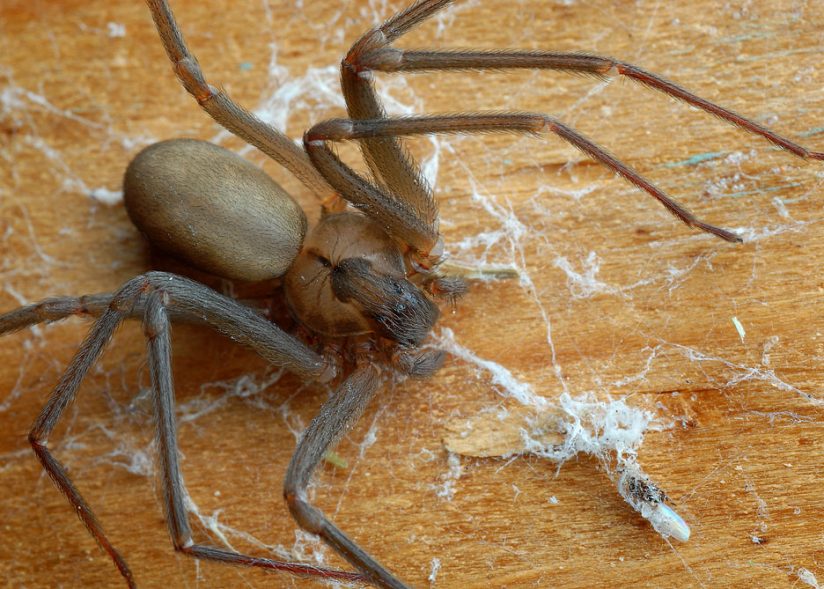
Brown recluse spiders, Loxosceles reclusa, have only six eyes arranged in pairs, which differentiates them from many other spiders. Adults usually have a dark, violin-shaped mark on the cephalothorax with the neck pointing back toward the abdomen. They are usually light to dark brown and have no spines on their legs.
Recluse spiders are most active at night but can occasionally be seen during the day. They actively hunt insects and other arthropods and do not use a web to trap their prey. Their web is used mostly as a retreat where they place and protect eggs.
As their name implies, recluse spiders are generally shy. They hide in cracks and crevices, which they line with silk.
Outdoors, recluse spiders are found in stacked firewood, under stones, in rock ledges, under wood stored on the ground and under the bark on dead trees. Indoors they live in attics, crawl spaces, and living areas of the home. They prefer to hide in dry, narrow crevices, under insulation, and in wall voids.
Females lay one to two egg masses per year in dark, sheltered areas. Brown recluse egg cases are about ⅝ inch in diameter, flat on the bottom, and convex on top.
Brown recluse spiders bite when they are trapped or pressed against the skin. These spiders may bite if you accidentally roll over one in a bed or put on clothing that has a spider inside. Bites also occur when people clean garages and barns.
Recluse spider venom breaks down skin and muscle tissue at the bite location. The initial bite may be painless and become mild to severely painful 2 to 8 hours later. The bite site may also itch, swell, and become tender.
A blister usually forms about 24 hours after the bite and a slow-healing lesion forms within 1 week. Reactions to recluse bites depend on a person’s age, health, and body chemistry and the amount of venom injected. In severe cases, surgery may be needed to clean the wound and minimize scarring.
Diagnosis of a recluse spider bite can be difficult because Staphylococcus and other bacteria can cause similar lesions. If you think a brown recluse or other spider has bitten you, kill the spider and take it to the doctor for identification. If it is a recluse spider, the doctor can provide the required treatment.
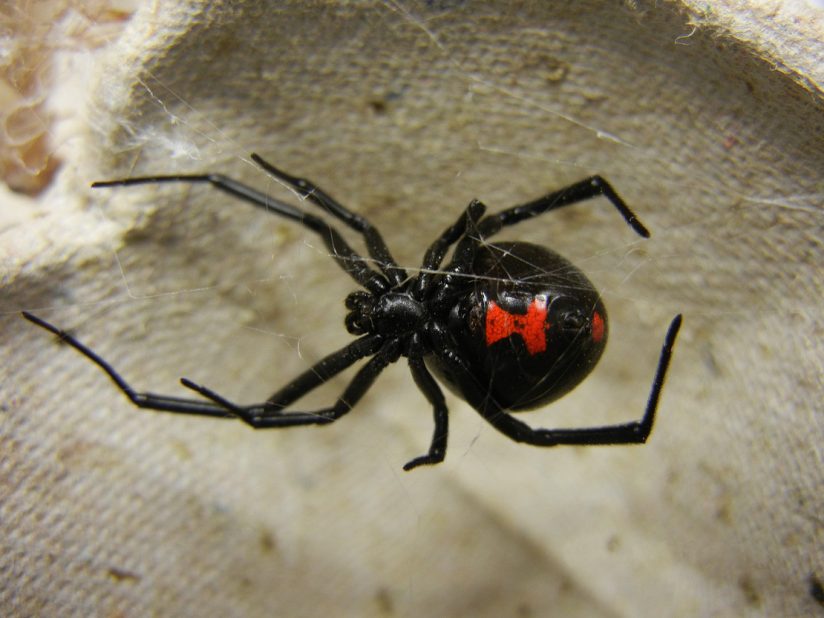
The southern black widow, Latrodectus mactans, and its relatives live throughout the United States. Other widow species found in Texas include the western black widow, L. hesperus; the northern black widow, L. variolus; and the brown widow, L. geometricus. Coloration varies considerably among species.
Adult female widow spiders are typically black. Males and juveniles may have orange, red and white markings on the back and sides. The abdomen is rounded and the ventral region often has two reddish triangles that form an hourglass shape. Some of these spiders have irregular or spotlike markings; others have no markings at all.
Female adults average 1 1/2 inches long; adult males are much smaller. Widow spiders have eight eyes in two rows.
Widow spiders are usually found in protected areas outdoors or in structures that are open to the outdoors. They may live in wood piles, garages, cellars, shrubbery, crawl spaces, rain spouts, termite bait stations, gas and electric meters, and other rarely disturbed places.
Black widow spiders build strong, sticky, irregular webs. They typically hang upside down in the web, revealing the hourglass markings. The egg sacs are rounded, about one-half inch long, and hang from the web. Females may make more than one egg sac. Newly hatched spiderlings usually stay near the egg sac for a few days before they disperse by ballooning.
Widow spiders most often bite when they are threatened or pressed against the skin. People may be bitten when they accidentally disturb a spider or its web.
Widow spider toxin affects the nervous system. Initially, there may be a pinprick sensation that becomes red and swollen. The bite site usually turns pale in the center and it is surrounded by a tender redness.
Within 1 to 3 hours, the person may experience moderate to intense pain throughout the body that could last from 2 to 3 days. Other symptoms include tremors, nausea, vomiting, leg cramps, abdominal pain, profuse perspiration, loss of muscle tone, and increased blood pressure.
Bites can be more dangerous for children, the elderly, and people with health problems. Few cases have been fatal.
Seek medical care for a black widow bite; the patient should be taken to a hospital emergency room to receive the appropriate antivenom.
